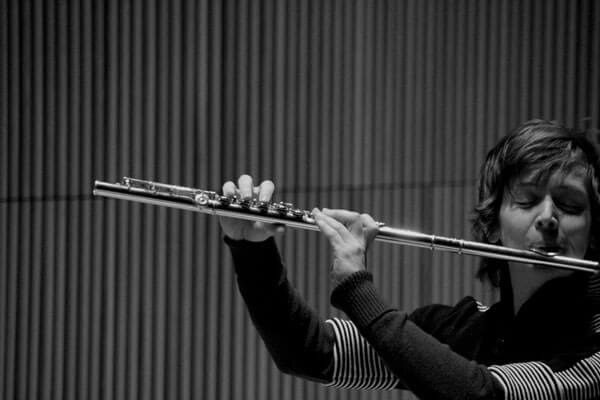Claire Chase is a flutist and artistic director/CEO of the International Contemporary Ensemble. A fierce advocate of contemporary music, she has commissioned over 100 new works for the flute and with ICE she has been responsible for the world premiere of over 500 works. Claire will release her third solo album, Density, on October 1. I spoke to her about the new album, the overall process of recording, and what her new record label, TUNDRA, is all about.
Varèse’s Density 21.5 is nearly 80 years old; that’s practically another world for the field of music you’re working in! So what’s its significance today and specifically for this album? What keeps it relevant to you as a performer?
For me, Density is, hands down, the greatest solo flute work of the 20th century and as yet, the greatest in the 21st. In my book it’s up there with the greatest solo flute works of all time, including Bach’s searching solo A minor Partita, Debussy’s sensuous Syrinx, and Berio’s slapstick and wonderful Sequenza I.
I was obsessed with the piece as a nerdy teenager and tried unsuccessfully to program it at my junior high school graduation (in a public school in Southern California). I was shot down and had to play Danny Boy instead. But my love affair with the piece only intensified, and it has continued to intensify for the last several decades. My ultimate dream is that by the 100th anniversary of the piece in 2036 I will have commissioned or in some way had a role in giving birth to the next great solo flute work that—like Density—redefines the possibility of the instrument and sets a new standard for an entire century.

One of the joys of watching you perform is the overt theatricality of your playing, seeing how you embody certain musical gestures. Do you find yourself performing in a similar manner when you’re in the studio? Is there a separate recording etiquette or do you feel like you still need to “get into it” to achieve the right musical results?
Oh, man. So many teachers have tried to beat the physicality out of my playing—I can’t tell you how hard I have tried to play the flute standing still over the years—but there are some things you just can’t change about yourself. Playing the flute is athletic: you are breathing your entire being into this little tube of metal. Much like singing (and very much unlike any other wind instrument), there is very little resistance between you and the instrument. In other words, when you’re playing well, you are the instrument because your breath is the instrument. You have nothing to hide underneath. For me, this takes my whole body. I have a small body but I want to use all of it, every inch of it, to serve the breath.
If anything, I’m less inhibited in the studio and probably look like more of a freak in that setting because I can totally let it rip. And if I go overboard I can have a do-over!
Many of the pieces on this album call for, like, A LOT of flutes playing simultaneously. For a soloist doing all of those layered parts, this music seems ideally suited for a studio recording. Are you content with keeping any of this repertoire for the record alone or will it always have a place in live performance? Do you find that there are particular pieces you would rather record than perform on a concert?
The record and the live show are very different experiences, obviously, because one of them is mixed and played perfectly and the trajectory from mass flute to “the one all alone” is utterly controlled; and the other is an intensely physical, human journey with a live body that is essentially in competition with the ‘machine-ized’ recorded version of herself. Woman versus machine!
I think that what will make the live show interesting is all of the mistakes, actually, the vulnerability and fragility and, frankly, the impossibility of a live flutist trying to keep up with (and also humanize, color, make ‘alive’) the recorded version of herself. The archival and the ephemeral are pitted against one another here.
I do feel a bit like I’m preparing for an olympic event of sorts in training for this show, because I’m doing the whole record from top to bottom without so much as pausing to catch a breath. I don’t want the tension released at any moment in the audience’s breath and focus on the unraveling (and gradual, granular focusing) of this sea of flutes. For me to ask that of a group of people I’ve got to really deliver on that on stage x 100,000. So in addition to practicing like a fiend I’ve been drinking lots of wheatgrass and doing lots of cardio this month.
Does a piece change for you at all after you have recorded it? Does your interpretation always continue to be mutable or do you develop a certain way of hearing the piece after making a sort of physical statement on it?
Oh, it changes completely. Often it’s a very painful process, because once you hear yourself immortalized you want to kill yourself all over again! I’m kidding. Recording is almost as excruciating in the self-seeking department as performing, and almost as exhilarating. But, much as I love recording and learn a great deal from it every time I do it, at the end of the day I’d always rather perform. I’d rather fall flat on my face in front of an audience trying to do something new than try to recreate that experience in the studio.
Considering that ICE demonstrates a fierce spirit of self-entrepreneurship, it seems only logical that you guys have created your own record label. Could you tell us about the conception for TUNDRA and what your hopes are for the label?
First, I should clarify that Density, which as a concept pre-dated the formation of TUNDRA, isn’t a TUNDRA release. TUNDRA is reserved for releases by ICE artists whose work focuses exclusively on world premiere recordings of music written by, for, and with ICE. Density doesn’t really fit into that category because there’s so much ‘classical’ music on it! Even—and perhaps especially!—as the boss, I’ve got to stick to the rules. TUNDRA was created to release and give exposure to music that simply wouldn’t have an outlet otherwise. Varèse, Reich, Lucier, and Glass are already well represented in the recorded canon, and we want TUNDRA to remain truly radical in the sense that it catalyzes very new work, with an emphasis on work by artists in our generation.
The other exciting thing about TUNDRA is that the releases will be entirely produced, managed, and curated by ICE artists. We want to eliminate any bureaucracy and any barrier that an artist might have in getting his or her music out there, whether in physical or digital form. Like everything at ICE, there is no ceiling to what we’re trying to do. Only sky! I wouldn’t be surprised if we had a TUNDRA release once a month starting next season. The group is already bubbling over with ideas.
Claire Chase will perform her new album Density in its entirety on September 29 at the Constellation in Chicago (details here). For more about Claire, visit her website and ICE’s.
























